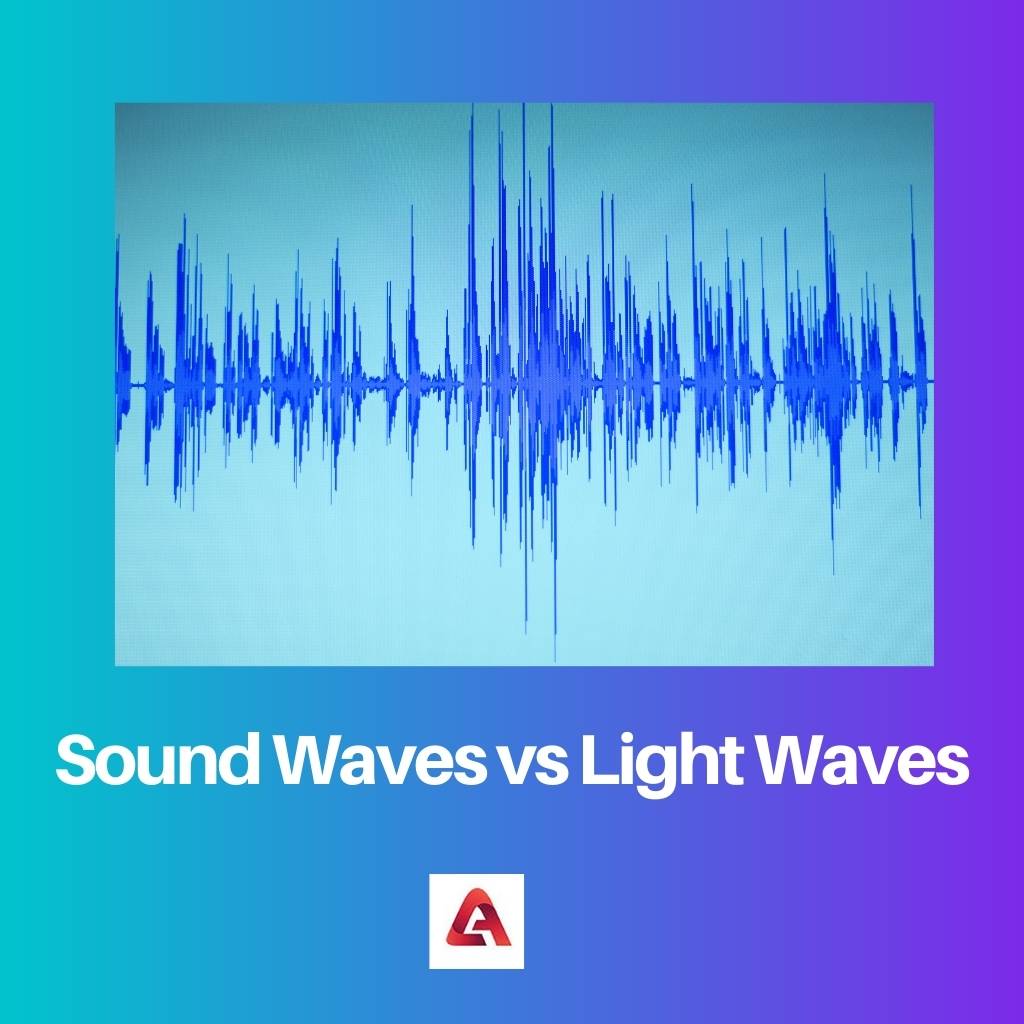We all have been tortured by the lessons of physics. But as physics is a culmination of natural things, we can not run far from it.
Key Takeaways
- Sound waves are mechanical waves that require a medium to travel.
- Light waves are electromagnetic waves that do not require a medium to travel.
- Sound waves travel slower than light waves.
Sound Waves vs Light Waves
Sound waves are mechanical waves that require a medium, like air or water, to travel and are perceived by the sense of hearing. Light waves are electromagnetic waves that can travel through the vacuum of space at the speed of light and are perceived by the sense of sight.

Longitudinal is the category of sound waves. These are mechanical waves and can travel through all three states that are solid, liquid, and gas.
Electromagnetic light waves are competent to travel without the help of any medium and, thus travel through a vacuum which is without any matter.
Comparison Table
| Parameters of Comparison | Sound Waves | Light Waves |
|---|---|---|
| Wave type | Sound waves are classified as mechanical waves. | Light waves are established as electromagnetic waves. |
| Production | Sound waves are produced by oscillating particles of the medium. | Light waves are produced by oscillating charged particles of the medium. |
| Medium | It needs a medium to travel. | It does not require any medium to travel. |
| Travel through vacuum | Sound waves are not qualified to travel through a vacuum. | Light waves can travel through a vacuum. |
| Wavelength | Sounds waves have a very long wavelength. | Light waves have a short wavelength in comparison. |
| Nature | Sound waves are longitudinal waves. | Light waves are transverse in nature. |
What are Sound Waves?
Sound waves exist as longitudinal waves. These waves travel through with the help of different mediums, such as air and water.
According to physics, sound is a vibration that propagates a wave, and this wave transmits through mediums like gas, liquid or solid.
Sound waves can be divided into two categories – compression and rarefaction. In compression, molecules of sound waves are compressed together.
Sound waves are called mechanical waves. Sound waves travel through air and water effortlessly, but they are incapable of traveling through a vacuum.

What are Light Waves?
Light is a part of the electromagnetic spectrum. This radiation is given to us by stars like the sun in the case of the earth.
Light waves do not depend on any sort of medium to travel, and this is why they can travel easily through a vacuum. In a vacuum, the speed of light waves is approximately 186,282 miles per second.
Light waves have three measurable properties, these are amplitude, frequency, and wavelength. Each wave of light possesses a wavelength.

Main Differences Between Sound Waves and Light Waves
- Sound waves are known as longitudinal waves, whereas light waves are transverse.
- Sound waves are generated by oscillating particles of the medium, while light waves are produced by charged particles of the oscillating of the medium.

- https://link.springer.com/article/10.1007/BF03035840
- https://link.springer.com/content/pdf/10.1007/BF03046242.pdf
Sound and light waves are two major concepts taught in physics. It is interesting to note that sound waves are mechanical waves that require a medium to travel, while light waves are electromagnetic waves that do not require a medium to travel, and how each is perceived differently by the sense of hearing and sight.
Yes, the difference in the medium for travel and the sense by which the waves are perceived is a key characteristic that sets sound waves apart from light waves.
Insightful information on the nature of sound and light waves. The comprehensive comparison table effectively highlights the unique characteristics of these waves and the differences in their behavior.
The division of sound waves into compression and rarefaction, and the properties of light waves such as amplitude, frequency, and wavelength, offer valuable insights into the behavior and characteristics of these waves. This information contributes to a holistic understanding of wave phenomena.
Indeed, exploring the distinct characteristics of sound and light waves enriches our knowledge of wave dynamics and the intricate properties of wave behavior.
The explanation of sound waves as longitudinal and light waves as transverse, along with the references provided, adds depth to our understanding of wave properties and the fundamentals of wave behavior.
The detailed exploration of sound and light waves, along with the references for further reading, provides a robust foundation for comprehending the underlying principles of wave dynamics.
Absolutely, the elucidation of the categorization and nature of these waves enhances our knowledge of the distinctions between sound and light waves.
The main differences between sound waves and light waves, such as their generation and nature, provide a comprehensive overview of their distinct properties and behavior. The references cited further underscore the credibility of the information presented.
The in-depth exploration of the parameters and nature of sound and light waves deepens our understanding of the complexities of wave behavior and the differences between these two fundamental types of waves.
The detailed explanation of the primary variances between sound and light waves is immensely beneficial for understanding the fundamental concepts governing wave phenomena.
Sound waves, being mechanical waves, and light waves, as electromagnetic waves, exhibit compelling differences. Exploring the categorization of sound waves as longitudinal and light waves as transverse further highlights the unique qualities of each type of wave.
Yes, delving into the nature of sound and light waves reveals the intricacies of wave behavior and the important role these waves play in our understanding of the physical world.
The detailed description of sound and light waves, along with their differences, is highly informative and illuminating. The references provided further establish the credibility of the information presented.
Understanding the characteristics of sound waves as mechanical waves and light waves as electromagnetic waves contributes to a deeper understanding of wave propagation and behavior. The categorization of these waves based on their nature and travel properties is essential for grasping their distinct features.
Indeed, the detailed explanations help in unraveling the complexities of wave dynamics and the nuanced differences between sound and light waves.
The comparison between sound waves and light waves provides valuable insights into their respective properties. It’s fascinating how these waves are produced and the mediums through which they travel, showcasing the diversity of wave behavior in nature.
Absolutely, understanding the differences in production and medium requirements helps in grasping the distinct characteristics of sound and light waves.
Learning about the unique qualities of sound and light waves enhances our knowledge of physics and the fundamental principles governing wave phenomena.
Understanding the parameters of comparison makes it easier to differentiate between sound waves and light waves. For instance, while sound waves require a medium to travel, light waves can travel through a vacuum. It’s fascinating to see how these properties affect the nature of each type of wave.
The nature of these waves is quite intriguing, especially the fact that sound waves are longitudinal while light waves are transverse. Understanding these differences can lead to a greater appreciation for the complexity of physics.
Absolutely, seeing the fundamental differences between these two types of waves provides a deeper understanding of their behavior and characteristics.